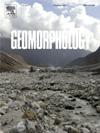近水平岩岸平台的折射特性及其对谐波和静波模式影响的数值研究
IF 3.1
2区 地球科学
Q2 GEOGRAPHY, PHYSICAL
引用次数: 0
摘要
近水平海岸平台的平面形状极不规则,但人们对这些不规则性如何影响平台上的显著波高(Hŝ)以及近岸波场的频率成分知之甚少。由于海浪与光线具有相似的折射特性,因此可以假定,与光学透镜类似,海岸平台可以根据其几何形状按频率分离海浪。因此,我们使用非线性布森斯克波模型进行谐波和双谱模式分解分析,研究凹凸平台边缘对风浪(WW:0.125-0.33 Hz)、涌浪(SW:0.05-0.125 Hz)和次重力波(IG:0.008-0.05 Hz)频率的控制。对于断裂波和非断裂波,增加平台边缘凹度会加强波的发散,进而削弱外平台上的 SW 波和 IG 波,使 Hŝ 降低达 25%。增加平台边缘凸度会加强外平台上 SW 波和 WW 波的聚焦和放大,使 Hŝ在破浪和非破浪时分别增加 18%和 55%。在有破波的情况下,IG 的放大受波浪在内部平台发散的影响,这一条件由临界凸曲率阈值(K=1.8)决定,该阈值平衡了折射产生的波浪聚焦和破波产生的波浪散焦。我们发现,凸曲率可决定跨平台的 WW、SW 和 IG 的相对优势。在沿岸,相干波的相互作用支配着由平台中心线附近的一个节点和凹边两侧的两个反节点所定义的 IG 固定模式。K>1.8 时,在平台中心线处产生一个节点,在凸边两侧观察到两个反节点,K<1.8 时则观察到相反的模式。这种模式可能是波浪产生的水流沿岸变化和侵蚀岩石海岸的结果。本文章由计算机程序翻译,如有差异,请以英文原文为准。
Numerical investigation of the refractive properties of near-horizontal rocky shore platforms and their effects on harmonic and stationary wave patterns
Near-horizontal shore platforms display highly irregular plan shapes, but little is known about the way in which these irregularities influence the significant wave height () on the platforms and the frequency components of the nearshore wavefield. As ocean waves share akin refractive properties to light rays, it can be assumed that, similarly to optical lenses, shore platforms can separate waves according to their frequency depending on their geometry. Thus, we use a non-linear Boussinesq wave model to conduct harmonic and bispectral mode decomposition analyses to study the control of concave and convex platform edges over wind waves (WW: 0.125–0.33 Hz), swell waves (SW: 0.05–0.125 Hz) and infragravity (IG: 0.008–0.05 Hz) waves frequencies. For breaking and non-breaking waves, increasing the platform edge concavity intensified wave divergence and subsequent attenuation of SW and IG across the outer platforms, reducing by up to 25 %. Increasing the platform edge convexity intensified focusing and amplification of SW and WW over the outer platforms, increasing by up to 18 % and 55 % for breaking and non-breaking waves. In the presence of breaking, IG amplification was affected by wave divergence across the inner platform, a condition determined by a critical convex curvature threshold (=1.8) balancing wave focusing from refraction and defocusing from breaking. We find that convex curvature can determine the relative dominance of WW, SW and IG across platforms. Alongshore, coherent wave interactions governed IG stationary patterns defined by a node near the platform centreline and two antinodes on either side of concave edges. A node was generated at the platform centreline, and two antinodes were observed on either side of the convex edges for >1.8, with the opposite pattern observed for <1.8. Such patterns likely result in alongshore variations in wave-generated currents and erosion shaping rock coasts.
求助全文
通过发布文献求助,成功后即可免费获取论文全文。
去求助
来源期刊

Geomorphology
地学-地球科学综合
CiteScore
8.00
自引率
10.30%
发文量
309
审稿时长
3.4 months
期刊介绍:
Our journal''s scope includes geomorphic themes of: tectonics and regional structure; glacial processes and landforms; fluvial sequences, Quaternary environmental change and dating; fluvial processes and landforms; mass movement, slopes and periglacial processes; hillslopes and soil erosion; weathering, karst and soils; aeolian processes and landforms, coastal dunes and arid environments; coastal and marine processes, estuaries and lakes; modelling, theoretical and quantitative geomorphology; DEM, GIS and remote sensing methods and applications; hazards, applied and planetary geomorphology; and volcanics.
 求助内容:
求助内容: 应助结果提醒方式:
应助结果提醒方式:


